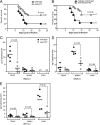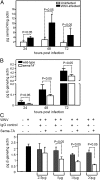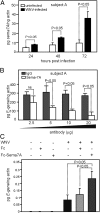Semaphorin 7A contributes to West Nile virus pathogenesis through TGF-β1/Smad6 signaling
- PMID: 22896629
- PMCID: PMC3496209
- DOI: 10.4049/jimmunol.1201140
Semaphorin 7A contributes to West Nile virus pathogenesis through TGF-β1/Smad6 signaling
Abstract
Semaphorin 7A (Sema7A) is a membrane-associated/secreted protein that plays an essential role in connecting the vertebrate neuronal and immune systems. However, the role of Sema7A has not been elucidated in viral pathogenesis. In this study, we show that abrogation of Sema7A protects mice from lethal West Nile virus (WNV) infection. Mice lacking Sema7A showed increased survival, reduced viral burden, and less blood-brain barrier permeability upon WNV infection. Increased Sema7A levels were evident in murine tissues, as well as in murine cortical neurons and primary human macrophages upon WNV infection. Treatment with Sema7A Ab blocked WNV infection in both of these cell types. Furthermore, Sema7A positively regulates the production of TGF-β1 and Smad6 to facilitate WNV pathogenesis in mice. Collectively, these data elucidate the role of Sema7A in shared signaling pathways used by the immune and nervous systems during viral pathogenesis that may lead to the development of Sema7A-blocking therapies for WNV and possibly other flaviviral infections.
Figures






Similar articles
-
Semaphorin 7a+ regulatory T cells are associated with progressive idiopathic pulmonary fibrosis and are implicated in transforming growth factor-β1-induced pulmonary fibrosis.Am J Respir Crit Care Med. 2013 Jan 15;187(2):180-8. doi: 10.1164/rccm.201206-1109OC. Epub 2012 Dec 6. Am J Respir Crit Care Med. 2013. PMID: 23220917 Free PMC article.
-
Semaphorin 7A promotes endothelial to mesenchymal transition through ATF3 mediated TGF-β2/Smad signaling.Cell Death Dis. 2020 Aug 10;11(8):695. doi: 10.1038/s41419-020-02818-x. Cell Death Dis. 2020. PMID: 32826874 Free PMC article.
-
CCR5 limits cortical viral loads during West Nile virus infection of the central nervous system.J Neuroinflammation. 2015 Dec 15;12:233. doi: 10.1186/s12974-015-0447-9. J Neuroinflammation. 2015. PMID: 26667390 Free PMC article.
-
The Interferon-Stimulated Gene Ifitm3 Restricts West Nile Virus Infection and Pathogenesis.J Virol. 2016 Aug 26;90(18):8212-25. doi: 10.1128/JVI.00581-16. Print 2016 Sep 15. J Virol. 2016. PMID: 27384652 Free PMC article.
-
The innate immune adaptor molecule MyD88 restricts West Nile virus replication and spread in neurons of the central nervous system.J Virol. 2010 Dec;84(23):12125-38. doi: 10.1128/JVI.01026-10. Epub 2010 Sep 29. J Virol. 2010. PMID: 20881045 Free PMC article.
Cited by
-
Emerging roles of Semaphorins in the regulation of epithelial and endothelial junctions.Tissue Barriers. 2013 Jan 1;1(1):e23272. doi: 10.4161/tisb.23272. Tissue Barriers. 2013. PMID: 24665374 Free PMC article. Review.
-
Semaphorins in immune cell function, inflammatory and infectious diseases.Curr Res Immunol. 2023 May 31;4:100060. doi: 10.1016/j.crimmu.2023.100060. eCollection 2023. Curr Res Immunol. 2023. PMID: 37645659 Free PMC article. Review.
-
Host genetic control of mosquito-borne Flavivirus infections.Mamm Genome. 2018 Aug;29(7-8):384-407. doi: 10.1007/s00335-018-9775-2. Epub 2018 Aug 25. Mamm Genome. 2018. PMID: 30167843 Free PMC article. Review.
-
Degeneration and regeneration of corneal nerves in response to HSV-1 infection.Invest Ophthalmol Vis Sci. 2015 Jan 13;56(2):1097-107. doi: 10.1167/iovs.14-15596. Invest Ophthalmol Vis Sci. 2015. PMID: 25587055 Free PMC article.
-
Integrated analysis of microRNAs and their disease related targets in the brain of mice infected with West Nile virus.Virology. 2014 Mar;452-453:143-51. doi: 10.1016/j.virol.2014.01.004. Epub 2014 Jan 31. Virology. 2014. PMID: 24606691 Free PMC article.
References
-
- Petersen L. R., Marfin A. A. 2002. West Nile virus: a primer for the clinician. Ann. Intern. Med. 137: 173–179 - PubMed
-
- Diamond M. S., Klein R. S. 2004. West Nile virus: crossing the blood-brain barrier. Nat. Med. 10: 1294–1295 - PubMed
-
- Lustig S., Olshevsky U., Ben-Nathan D., Lachmi B. E., Malkinson M., Kobiler D., Halevy M. 2000. A live attenuated West Nile virus strain as a potential veterinary vaccine. Viral Immunol. 13: 401–410 - PubMed
Publication types
MeSH terms
Substances
Grants and funding
LinkOut - more resources
Full Text Sources
Other Literature Sources
Molecular Biology Databases

